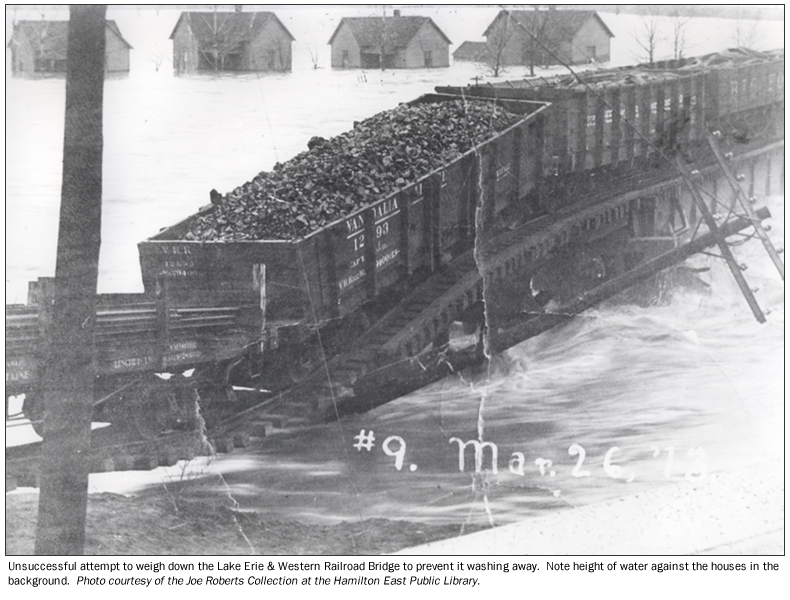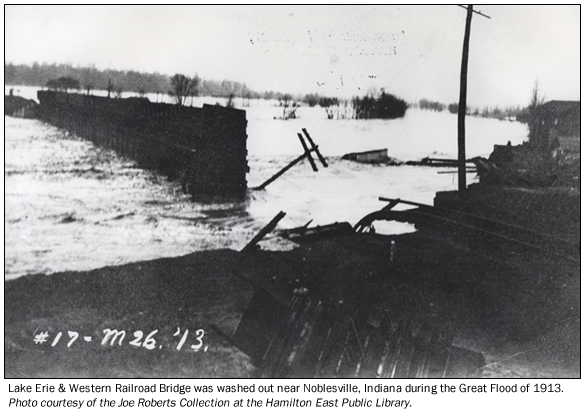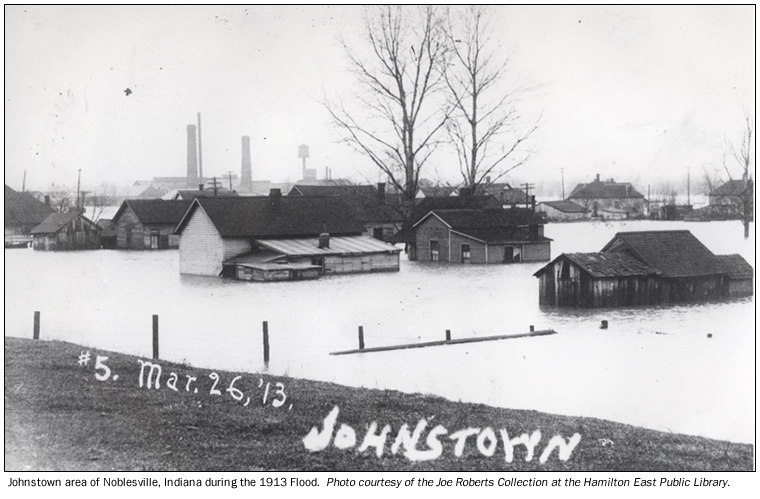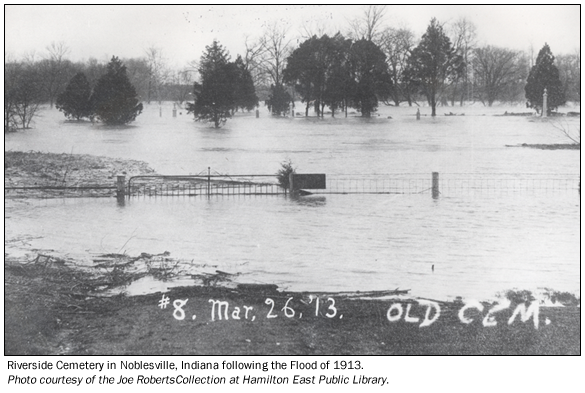The Great Flood of 1913
100 Years Later
Community Profiles: Noblesville, Indiana
| River: | White |
| Storm Total Rainfall: | |
| Known Fatalities: |
Timeline
The following article written by Nancy A. Massey, Hamilton East Public Library.
According to newspaper accounts at the time, rain started falling on Saturday, March 22, 1913. By Easter Sunday, March 23, it was quite a downpour. It rained all day Monday, March 24. The rain with the spring thaw caused the river to rise. On Wednesday, March 26, the White River overflowed its banks causing devastation throughout Hamilton County and effectively cut Noblesville off from the rest of the county. For the first time, the business district of Noblesville was threatened with damage by water from the river.
For several hours on Tuesday, March 25, a force of men built a levee on North Ninth Street. Sand bags piled three feet high were banked together on the west side of the traction line midway between the interurban sub-station and the end of the brick pavement. The traction line north of the city was under water and most of the grade had been washed away.

 Since Tuesday afternoon, swirling flood water struck the iron frame work beneath the Lake Erie & Western Railroad Bridge. Freight cars loaded with coal were run onto the bridge in an effort to hold it down. The raging floodwater proved to be stronger than the bridge and the framework gave way dumping two cars into the river.
Since Tuesday afternoon, swirling flood water struck the iron frame work beneath the Lake Erie & Western Railroad Bridge. Freight cars loaded with coal were run onto the bridge in an effort to hold it down. The raging floodwater proved to be stronger than the bridge and the framework gave way dumping two cars into the river.
The Water Works closed down that Tuesday night when the levee built earlier that day broke. Water filled the pumping station to a depth of about six feet. Water backed through drainage sewers into the basements of businesses and houses near the river. Closing of the water works caused hundreds of homes to be without clean water and left the city without fire protection. The loss of electric power plunged homes into darkness.
Impacts
The southwest area of Noblesville, known as Johnstown, was one of the hardest hit parts. It was known as Johnstown (named after Johnstown, Pennsylvania which was hit by a devastating flood in 1889) because that area was known to flood a lot. One of its residents, Mr. McCoy, apparently stated on Monday the 24th that he would not leave his home because of a little rising water. A newspaper account reports that he was alleged to have said, “That if the Lord so willed it he might as well die then and there as any place.” On Tuesday morning, he was hauled to safety by boat after changing his mind. All of the Johnstown residents below Fifth Street were forced to leave their homes.

Three feet of water covered the Riverside Cemetery destroying the recent improvements made to the cemetery. Monuments were knocked over; some were swept away from the force of the raging waters. Worse yet, some graves were disturbed. Monument pieces found down the river were later recovered and place together in a cement area since it  was not known to which graves they belonged.
was not known to which graves they belonged.
After the floodwaters subsided, recovery efforts emerged. Food and clothing were given to those who lost their homes. The Christian Church served free meals and grocers gave away baskets of free food. Downtown stores donated clothing. The Star Theatre held a matinee with the proceeds going to flood victims. Harrell Hospital and the Methodist Episcopal Church offered temporary shelter.
Flood Protection Measures
There are no US Army Corp of Engineers Flood Protection projects upstream of Noblesville. Flood mitigation in recent years focused on buying properties in the flood plain.

